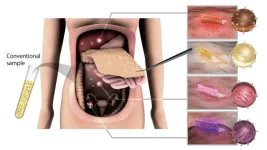(Press-News.org) General anesthesia evokes a dual mystery: How does it disrupt consciousness, including sensory perception, and what might that say about the nature of consciousness. A new study led by researchers at The Picower Institute for Learning and Memory at MIT provides evidence in animals that consciousness depends on properly synchronized communication across the brain’s cortex and that the anesthetic drug propofol cancels sensory processing by cutting it off.
In the Journal of Cognitive Neuroscience, researchers report clear evidence that in anesthetized animals, sounds and tactile sensations still produced neural activity in an area of the cortex that receives incoming sensory information. But just as clearly, measurements of neural spiking and broader oscillatory activity showed that those signals failed to propagate to three other cortical regions with higher-level processing and cognitive responsibilities, as seen during normal wakefulness.
“What this study shows is that the cortex isn't getting on the same page,” said study corresponding author Earl K. Miller, Picower Professor in the Department of Brain and Cognitive Sciences at MIT. “Information is making it to the cortex. It’s being registered in primary sensory areas. It’s just not reaching the rest of the cortex. Because of the anesthesia, it only makes it part of the way through.”
The significance of that, said co-senior author Emery N. Brown, Edward Hood Taplin Professor of Medical Engineering and Computational Neuroscience, is that “the study suggests that consciousness requires coordination of activities among cortical regions. Simply activating one or more of these regions is not sufficient.”
Study lead author John Tauber, who recently earned his Ph.D. at MIT in Brown’s lab, said the study could aid efforts to improve anesthesiology care. Brown is an anesthesiologist at Massachusetts General Hospital as well as an MIT professor of Brain and Cognitive Sciences, a member of the Institute for Medical Engineering and Science, and a faculty member of Harvard Medical School.
“We hope our paper further highlights the importance of actively monitoring what is happening in the brain during anesthesia,” Tauber said. “Future studies in this direction will help us develop clear indicators of whether a patient is still processing sensory information. This would allow anesthesiologists to adjust drug dosage and prevent intraoperative awareness from occurring.”
Stymied sensory processing
To conduct the study the team worked with two animal subjects to measure brain activity—both the electrical “spiking” of individual neurons and their collective rhythmic activity—via electrode arrays placed in four areas of the cortex both before and after they underwent propofol general anesthesia. The researchers selected the areas of the cortex to represent its hierarchical continuum of functions from initial sensation (the superior temporal gyrus, or STG) to increasingly high levels of cognition (the posterior parietal cortex, or PPC; Region 8A; and the prefrontal cortex, or PFC).
During both states of consciousness, the animals experienced specific stimulations: two audio tones, including one on its own and another paired with a puff of air on the face. In the awake state, such stimulation produced an increase all cortical areas in alpha/beta frequency activity. STG also showed a strong increase in higher frequency oscillations. The response changed dramatically under anesthesia. While the alpha and beta frequency response was diminished in STG, it virtually vanished in all the higher cortical regions.
“We expected to see a more gradual loss of responses and information,” Tauber said. “The drop-off in responses during anesthesia from auditory cortex (STG) to associative cortex (PPC) was striking.”
Along with the decrease in activity, the researchers measured a decrease in the sensory information detectable in the brain as they moved up the cortical hierarchy. “Decoder” software found sensory information in all areas of the cortex during the awake state but during unconsciousness, less and less information could be found the higher up the cortex the researchers looked.
An incoherent cortex
When the researchers next measured the synchronization of activity among brain regions, they found that it, too, broke down under anesthesia. When animals were awake, they exhibited a strong degree of synchronization in alpha/beta oscillation activity but when unconscious, “there was little or no stimulus-induced synchronization for any of the pairs of cortical areas,” the researchers reported.
A feature of the propofol-anesthetized brain is that neural oscillation activity takes on distinct “up” and “down” states of greater or lesser activity over time. To test whether sensory information is cut off during both states or just the down states, the researchers developed a statistical analysis. They found that while all neuronal spiking was indeed low during the down states, even during up states when sensory signals were measurable in STG they still failed to go beyond that region.
“We expected responses in the higher cortical areas to at least be disrupted during up states, but it was a bit surprising to find the responses disappeared almost entirely,” Tauber said. “The neural activity during up states is functionally quite different from the awake state, but we think we have just scratched the surface in understanding the differences between the two.”
In sum, the evidence in the new study shows that unconsciousness doesn’t arise from a wholesale shutting down of the cortex, as much as a suppression of communication within it, Miller said.
A key next question to answer is how propofol enforces that suppression.
“What is it about these changing dynamics that blocks the flow of information through cortex?” Miller asks. “What’s the headwind that’s blowing back that sensory information and keeping it in the sensory cortex?”
Tauber added that the team looked at sensory processing only when they were certain the animals were fully unconscious. It could be informative, he said, to study how sensory processing changes during the transition from wakefulness to that fully unconscious state.
In addition to Tauber, Miller and Brown, the paper’s other authors are Scott Brincat, Emily Stephen, Jacob Donoghue and Leo Kozachkov.
The National Institutes of Health, The Office of Naval Research, The JPB Foundation and The Picower Institute for Learning and Memory funded the research.
END
Anesthesia blocks sensation by cutting off communication within the cortex
Under propofol general anesthesia, sensory input still reaches the brain, but signals do not spread. Results suggest consciousness requires cortical regions to all be “on the same page”
2023-11-08
ELSE PRESS RELEASES FROM THIS DATE:
Genetics of nearby healthy tissue may help catch lung cancer’s return
2023-11-08
Genetic information collected from seemingly healthy tissue near lung tumors may be a better predictor of whether cancer will come back after treatment than analysis of the tumors themselves, according to new research led by NYU Langone Health and its Perlmutter Cancer Center.
The new study focuses on lung adenocarcinoma, a cancer that forms in alveolar epithelial cells and accounts for about a third of all lung cancers in the United States, according to the U.S. Centers for Disease Control and Prevention. Most patients are cured if tumors are surgically removed early in the disease’s progression, but residual ...
Scientists engineer potent immune cells for ‘off-the-shelf’ cancer immunotherapy
2023-11-08
UCLA scientists have developed a new method to engineer more powerful immune cells that can potentially be used for “off-the-shelf” cell therapy to treat challenging cancers.
“Off-the-shelf” cell therapy, also known as allogenic therapy, uses immune cells derived from healthy donors instead of patients. The approach can bring cell therapies, like chimeric antigen receptor (CAR) T cell therapy, to more patients in a timelier manner, which is one of the major barriers in getting these life-saving treatments to patients.
“Time is often of the essence when it comes to treating people with advanced cancers,” said Lili Yang, associate professor ...
Extracellular vesicles captured using sustainable wood celluose-based nanofiber sheets may identify and improve cancer treatment
2023-11-08
A research team in Japan, led by Nagoya University’s Akira Yokoi, has developed an innovative technique using cellulose nanofiber (CNF) sheets derived from wood cellulose to capture extracellular vesicles (EVs) from fluid samples and even organs during surgery. EVs are small structures from cancerous cells that play a crucial role in cell-to-cell communication. Extracting and analyzing EVs using this new technology has the potential to revolutionize early cancer diagnosis and open the door to personalized medicine. The researchers published their findings in Nature Communications.
Cancer is notorious for its poor prognosis and in many cases goes undetected until its ...
Researchers identify brain network that is uniquely activated through injection vs. oral drug use
2023-11-08
Results from a new clinical trial suggest that a group of brain regions known as the “salience network” is activated after a drug is taken intravenously, but not when that same drug is taken orally. When drugs enter the brain quickly, such as through injection or smoking, they are more addictive than when they enter the brain more slowly, such as when they are taken orally. However, the brain circuits underlying these differences are not well understood. This study offers new information that helps explain what may be causing this difference.
The study was published in Nature Communications and led by researchers at the National Institute on Drug Abuse (NIDA) and the National ...
Genes, cells, and embryos in development and evolution: Pere Alberch, 25 years on
2023-11-08
The last 40 years have witnessed a deep transformation in our views of animal development. From seeing development a multicellular black box where over time a mass of cells acquires shape to form organs and tissues, we now have a detailed account of this process in terms of gene expression, multicellular activity, and morphogenesis.
This new point of view has raised questions about the relationships between genes, cells, and organisms. These questions are impacting our thinking about evolution, ...
Rapid high-dose buprenorphine treatment strategy reduces opioid withdrawal in individuals using fentanyl
2023-11-08
Buprenorphine is a medication approved for pain and opioid dependence. New findings published in The American Journal on Addictions indicate that a transmucosal dose (which dissolves in the mouth) of buprenorphine followed by an injection of extended-release buprenorphine (BUP‐XR) may be an effective treatment for individuals with opioid use disorder who use fentanyl.
The results come from a recent secondary analysis of an open-label study in which 24 participants received a single 4 mg dose of transmucosal buprenorphine followed by an injection ...
Do allergic conditions increase the risk of developing Long-COVID after SARS-CoV-2 infection?
2023-11-08
In an analysis of published prospective studies of people of all ages with confirmed SARS-CoV-2 infection who were followed for at least 12 months, pre-existing allergic conditions were linked to higher risks of experiencing long-term symptoms associated with COVID-19, or Long-COVID.
The analysis, which is published in Clinical & Experimental Allergy, identified 13 relevant studies (with a total of 9,967 participants) published between January 1, 2020 and January 19, 2023.
Although the data as a whole from the studies suggested that individuals with asthma or rhinitis might be at increased risk of Long-COVID after SARS-CoV-2 ...
Does being a caregiver affect older women’s longevity?
2023-11-08
In an analysis published in the Journal of the American Geriatrics Society that included older US women, caregiving was associated with a lower risk of death over an average follow-up of 17.5 years.
In the analysis of 158,987 women aged 50–79 years when enrolled in the Women’s Health Initiative (a long-term national health study), 31.8% of women died during follow-up, and women who reported being a caregiver over 2 assessments 10 years apart had a 9% lower risk of dying from any cause compared with non-caregivers. Caregiving was also associated with lower risks of death from cardiovascular disease ...
Does having law enforcement officers at school benefit or harm students?
2023-11-08
A systematic review that analyzed the results of published studies concluded that school-based law enforcement (SBLE)—having sworn law enforcement officers stationed in schools on at least a part-time basis—is likely ineffective for keeping schools safe, and it may even have detrimental consequences.
The research, which is published in Campbell Systematic Reviews, included 32 studies that examined the relationship between SBLE presence and school-related outcomes including crime and behavior problems, perceptions of school, and student learning. The studies compared outcomes in schools with SBLE to those without SBLE, ...
Are some children genetically predisposed to poor sleep?
2023-11-08
Previous research has identified genetic variants associated with insomnia and sleep duration in adults. Now a study published in the Journal of Child Psychology and Psychiatry has found that these variants also likely affect sleep quality and quantity in children.
In the study of 2,458 children of European ancestry, children who were genetically predisposed to insomnia (based on a polygenic risk score developed for adults) had more insomnia-like sleep problems such as frequent awakenings or difficulty initiating sleep, as reported ...
LAST 30 PRESS RELEASES:
Securing AI systems against growing cybersecurity threats
Longest observation of an active solar region
Why nail-biting, procrastination and other self-sabotaging behaviors are rooted in survival instincts
Regional variations in mechanical properties of porcine leptomeninges
Artificial empathy in therapy and healthcare: advancements in interpersonal interaction technologies
Why some brains switch gears more efficiently than others
UVA’s Jundong Li wins ICDM’S 2025 Tao Li Award for data mining, machine learning
UVA’s low-power, high-performance computer power player Mircea Stan earns National Academy of Inventors fellowship
Not playing by the rules: USU researcher explores filamentous algae dynamics in rivers
Do our body clocks influence our risk of dementia?
Anthropologists offer new evidence of bipedalism in long-debated fossil discovery
Safer receipt paper from wood
Dosage-sensitive genes suggest no whole-genome duplications in ancestral angiosperm
First ancient human herpesvirus genomes document their deep history with humans
Why Some Bacteria Survive Antibiotics and How to Stop Them - New study reveals that bacteria can survive antibiotic treatment through two fundamentally different “shutdown modes”
UCLA study links scar healing to dangerous placenta condition
CHANGE-seq-BE finds off-target changes in the genome from base editors
The Journal of Nuclear Medicine Ahead-of-Print Tip Sheet: January 2, 2026
Delayed or absent first dose of measles, mumps, and rubella vaccination
Trends in US preterm birth rates by household income and race and ethnicity
Study identifies potential biomarker linked to progression and brain inflammation in multiple sclerosis
Many mothers in Norway do not show up for postnatal check-ups
Researchers want to find out why quick clay is so unstable
Superradiant spins show teamwork at the quantum scale
Cleveland Clinic Research links tumor bacteria to immunotherapy resistance in head and neck cancer
First Editorial of 2026: Resisting AI slop
Joint ground- and space-based observations reveal Saturn-mass rogue planet
Inheritable genetic variant offers protection against blood cancer risk and progression
Pigs settled Pacific islands alongside early human voyagers
A Coral reef’s daily pulse reshapes microbes in surrounding waters
[Press-News.org] Anesthesia blocks sensation by cutting off communication within the cortexUnder propofol general anesthesia, sensory input still reaches the brain, but signals do not spread. Results suggest consciousness requires cortical regions to all be “on the same page”


